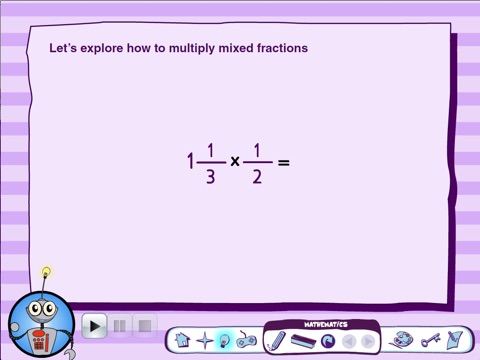
Learning Objective
Students will learn to:
• Interpret fractions as the division of the numerator by the denominator
• Convert mixed fractions to proper fractions
• Reduce fractions before multiplying
Grade Level(s)
4 5
Common Core Standards
5.NF.3 Interpret a fraction as division of the numerator by the denominator (a/b = a * b). Solve word problems involving division of whole numbers leading to answers in the form of fractions or mixed numbers, e.g., by using visual fraction models or equations to represent the problem. For example, interpret 3/4 as the result of dividing 3 by 4, noting that 3/4 multiplied by 4 equals 3, and that when 3 wholes are shared equally among 4 people each person has a share of size 3/4. If 9 people want to share a 50-pound sack of rice equally by weight, how many pounds of rice should each person get? Between what two whole numbers does your answer lie?
5.NF.4a Interpret the product (a/b) * q as a parts of a partition of q into b equal parts; equivalently, as the result of a sequence of operations a * q * b. For example, use a visual fraction model to show (2/3) * 4 = 8/3, and create a story context for this equation. Do the same with (2/3) * (4/5) = 8/15. (In general, (a/b) * (c/d) = ac/bd.)
5.NF.5b Explaining why multiplying a given number by a fraction greater than 1 results in a product greater than the given number (recognizing multiplication by whole numbers greater than 1 as a familiar case); explaining why multiplying a given number by a fraction less than 1 results in a product smaller than the given number; and relating the principle of fraction equivalence a/b = (n*a)/(n*b) to the effect of multiplying a/b by 1.



